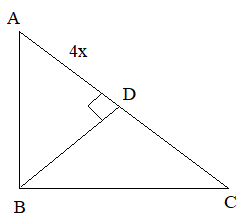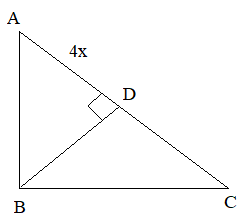
If in a right-angled triangle, the hypotenuse is four times as long as the perpendicular drawn to it from opposite vertex, then one of its acute angles is

A. \[{15^0}\]
B. \[{30^0}\]
C. \[{45^0}\]
D. None of these
Answer
217.2k+ views
Hint:
In this case, we are given that the in a right angled triangle, let us consider that as ABC the hypotenuse would be four times the perpendicular drawn from the one of side that is to its opposite vertex and we are to find the angle measurement of the other angle which is to be given as acute angle. For this we can use the hypotenuse formula of sin and cos. Solve using this concept to get the desired answer.
Formula used:
\[\sin \theta = \frac{{{\rm{opposite side}}}}{{{\rm{hypotenuse}}}}\]
\[\cos \theta = \frac{{{\rm{adjacent side}}}}{{{\rm{hypotenuse}}}}\]
Complete Step-by-Step Solution:
We have been provided in the question that
In a right-angled triangle, the hypotenuse is four times as long as the perpendicular drawn to it from the opposite vertex.
And we are to find the angle measurement of one of its acute angles.

Now, we have to consider a triangle, \[{\rm{ABC}}\] in which,
Let there
\[\angle {\rm{ACB}} = \theta ,{\rm{BD}} = {\rm{x}}\]
\[ \Rightarrow {\rm{AC}} = 4{\rm{x}}\]
Now, we have to write by using cos rule, we have
\[ \Rightarrow \cos \theta = \frac{{{\rm{BC}}}}{{{\rm{AC}}}} = \frac{{{\rm{BC}}}}{{4{\rm{x}}}}\]------ (1)
So, in by sine rule we obtain
\[ \Rightarrow \sin \theta = \frac{{{\rm{BD}}}}{{{\rm{BC}}}} = \frac{{\rm{x}}}{{{\rm{BC}}}}\]------- (2)
From the equation (1) and equation (2), we get
\[ \Rightarrow \sin \theta \cos \theta = \frac{1}{4}\]
Since we already known that the hypotenuse’s length is equal to = 4 (perpendicular length)
Now, we have to apply trigonometry identity to simplify further.
Since \[\sin 2\theta = 2\sin \theta \cos \theta \] we get
\[\sin 2\theta = {30^ \circ }\]
On solving for \[\theta \] we get
\[ \Rightarrow \theta = {15^ \circ }\]
Hence the angle according to the given problem is \[{15^ \circ }\]
Therefore, one of its acute angles is \[{15^ \circ }\]
Hence, the option A is correct
Note:
Students must be careful in applying the hypotenuse formula because it would be a little confusing. So if you are thorough with the hypotenuse formulas these types of problems are easy to solve. Like for calculating sin we will have the opposite side divided by hypotenuse and for cos it is the adjacent side divided by hypotenuse.
In this case, we are given that the in a right angled triangle, let us consider that as ABC the hypotenuse would be four times the perpendicular drawn from the one of side that is to its opposite vertex and we are to find the angle measurement of the other angle which is to be given as acute angle. For this we can use the hypotenuse formula of sin and cos. Solve using this concept to get the desired answer.
Formula used:
\[\sin \theta = \frac{{{\rm{opposite side}}}}{{{\rm{hypotenuse}}}}\]
\[\cos \theta = \frac{{{\rm{adjacent side}}}}{{{\rm{hypotenuse}}}}\]
Complete Step-by-Step Solution:
We have been provided in the question that
In a right-angled triangle, the hypotenuse is four times as long as the perpendicular drawn to it from the opposite vertex.
And we are to find the angle measurement of one of its acute angles.

Now, we have to consider a triangle, \[{\rm{ABC}}\] in which,
Let there
\[\angle {\rm{ACB}} = \theta ,{\rm{BD}} = {\rm{x}}\]
\[ \Rightarrow {\rm{AC}} = 4{\rm{x}}\]
Now, we have to write by using cos rule, we have
\[ \Rightarrow \cos \theta = \frac{{{\rm{BC}}}}{{{\rm{AC}}}} = \frac{{{\rm{BC}}}}{{4{\rm{x}}}}\]------ (1)
So, in by sine rule we obtain
\[ \Rightarrow \sin \theta = \frac{{{\rm{BD}}}}{{{\rm{BC}}}} = \frac{{\rm{x}}}{{{\rm{BC}}}}\]------- (2)
From the equation (1) and equation (2), we get
\[ \Rightarrow \sin \theta \cos \theta = \frac{1}{4}\]
Since we already known that the hypotenuse’s length is equal to = 4 (perpendicular length)
Now, we have to apply trigonometry identity to simplify further.
Since \[\sin 2\theta = 2\sin \theta \cos \theta \] we get
\[\sin 2\theta = {30^ \circ }\]
On solving for \[\theta \] we get
\[ \Rightarrow \theta = {15^ \circ }\]
Hence the angle according to the given problem is \[{15^ \circ }\]
Therefore, one of its acute angles is \[{15^ \circ }\]
Hence, the option A is correct
Note:
Students must be careful in applying the hypotenuse formula because it would be a little confusing. So if you are thorough with the hypotenuse formulas these types of problems are easy to solve. Like for calculating sin we will have the opposite side divided by hypotenuse and for cos it is the adjacent side divided by hypotenuse.
Recently Updated Pages
Area vs Volume: Key Differences Explained for Students

Mutually Exclusive vs Independent Events: Key Differences Explained

Addition of Three Vectors: Methods & Examples

Addition of Vectors: Simple Guide for Students

Algebra Made Easy: Step-by-Step Guide for Students

Relations and Functions: Complete Guide for Students

Trending doubts
JEE Main 2026: Application Form Open, Exam Dates, Syllabus, Eligibility & Question Papers

Derivation of Equation of Trajectory Explained for Students

Hybridisation in Chemistry – Concept, Types & Applications

Understanding the Angle of Deviation in a Prism

Understanding Collisions: Types and Examples for Students

How to Convert a Galvanometer into an Ammeter or Voltmeter

Other Pages
JEE Advanced Marks vs Ranks 2025: Understanding Category-wise Qualifying Marks and Previous Year Cut-offs

NCERT Solutions for Class 11 Maths Chapter 10 Conic Sections

NCERT Solutions for Class 11 Maths Chapter 9 Straight Lines

NCERT Solutions For Class 11 Maths Chapter 8 Sequences And Series

Understanding Atomic Structure for Beginners

NCERT Solutions For Class 11 Maths Chapter 12 Limits And Derivatives




